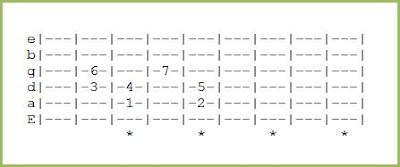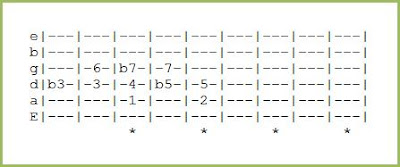In a guitar scale, the conventional approach to naming notes is through a number system. Let's take the notes in the Key of C Major as an example. The notes in the Key of C Major are: C, D, E, F, G, A and B.
Because the set of notes given above is in the Key of C Major, the "C" note in the set is called the "root" note. The root note in any key is always numbered as "1". Thus, the C note in the Key of C Major is 1.
Numbering the rest of the notes in the Key of C Major becomes relatively easier. D becomes 2 (or the 2nd note), E as 3, F as 4, G as 5, A as 6 and B as 7. Thus:
Translating these numbers on your guitar fretboard, we thus have something that looks like this:
Adding the "blues notes" (b3, b5 and b7) we have learned in a previous lesson, we have something that looks like this:
To "flatten" a note basically means to make it a half-step lower. For example, flattening G creates the note G Flat (Gb). Flattening E creates the note E Flat (Eb). C, when lowered half-step, becomes B. The F note, when flattened, creates the E note.
In short, flattening a note corresponds to lowering the note on your fretboard one fret.
Question: how can we know the notes belonging to a given major key so that we can also delegate the number for each note in the given major key?
Answer: use the "whole-whole-half-whole-whole-whole-half" method. How?
First, know the key you want to use. For example, we want to use Key of E. The E note on your fretboard automatically becomes the "root" note which is the same as number 1.
Next, count two frets from the E note on your guitar fretboard. The second fret from E is the second note in the Key of E. In this case, the second note (0r number 2) is F#. Two frets is equal to a whole step.
Next, count another two frets from the second note (F#). The note two frets from F# (or 2) is G#. Thus, in the Key of E Major, G# is the third note or 3.
Next, count one fret from the third note or G#. The note one fret from G# is A. Thus, in the Key of E Major, A is the fourth note or 4. One fret is equal to a half step.
Next, count two frets from the fourth note or A. The note two frets from A is B. Thus, in the Key of E Major, B is the fifth note or 5.
Next, count two frets from the fifth note or B. The note two frets from B is C#. Thus, in the Key of E Major, C# is the sixth note or 6.
Next, count two frets from the sixth note or C#. The note two frets from C# is D#. Thus, in the Key of E Major, D# is the seventh note or 7.
Lastly, count one fret from the seventh note or D#. The note one fret from D# is E. This brings us to the eight note or 8, which is also the root note: E. And we've just completed the notes belonging to the Key of E Major:

Follow the same steps in determining other notes which belong to any major key. After identifying the notes in the key, remember that the note where you began your step is always the 1 note. Then, follow the sequence.
-->>CONTINUE TO LESSON 7: THE E MINOR (Em) BLUES SCALE
<<--RETURN TO LESSON 5: THE "BLUES" NOTES